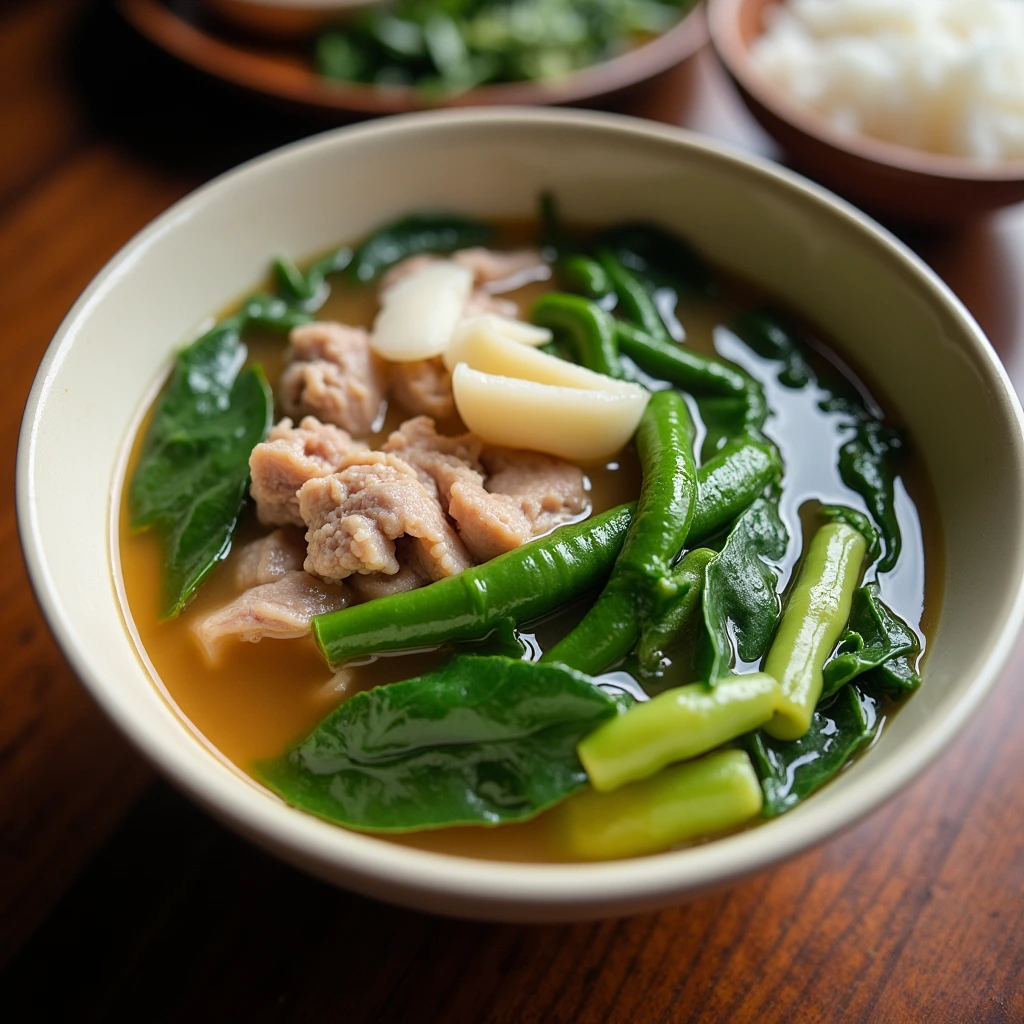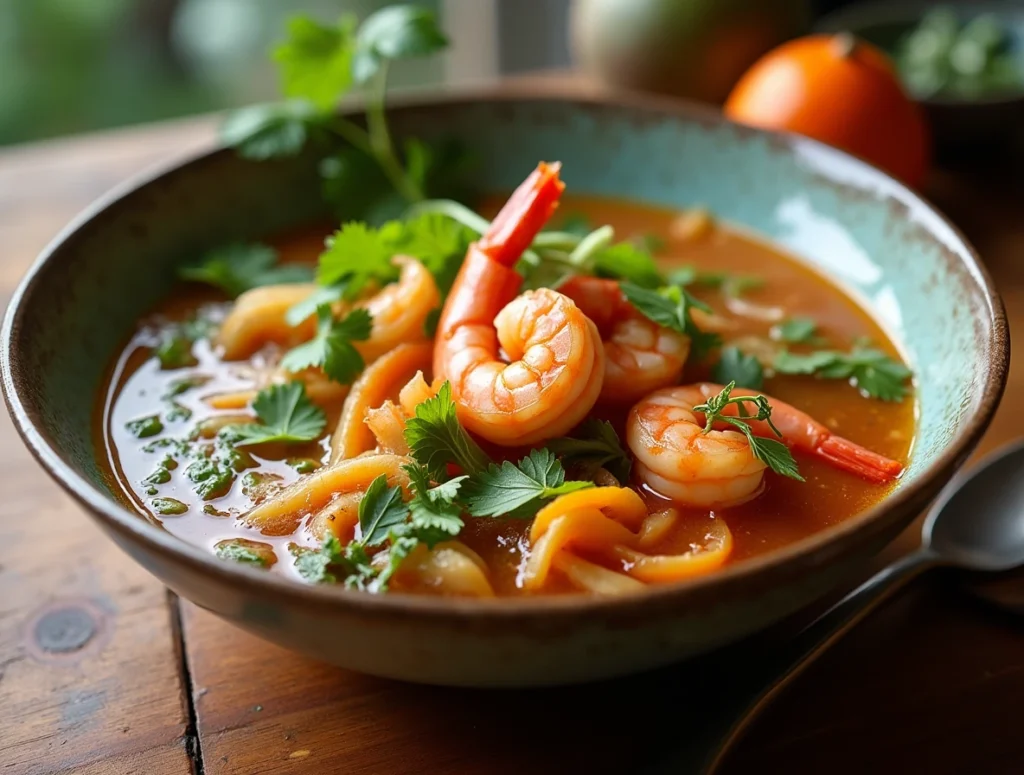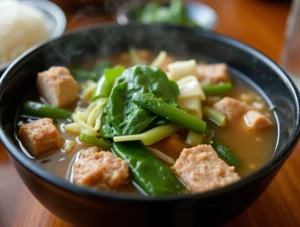Is Filipino Sinigang Healthy?
Filipino cuisine offers a delightful mix of flavors and textures, and one dish that consistently stands out is sinigang. This savory, sour stew is a staple in Filipino households, known for its tangy broth and hearty mix of vegetables and protein. But beyond its delicious appeal, an important question arises: Is Filipino sinigang healthy? The answer lies in its nutrient-packed ingredients, flexibility to cater to various diets, and undeniable cultural significance.
In this article, we’ll dive deep into what makes sinigang a beloved dish and explore its health benefits, nutritional composition, and adaptability. Whether you’re a long-time fan or curious about trying it for the first time, you’ll discover why sinigang is more than just comfort food—it’s a culinary gem with surprising health perks.
Table of Contents
What Makes Filipino Sinigang Healthy?

The Origins of Sinigang
Sinigang is a traditional Filipino stew characterized by its sour broth, often flavored with tamarind. This dish has been a staple in Filipino households for generations, offering a perfect balance of tangy, savory, and hearty flavors.
For an in-depth guide on this dish, explore What is sinigang made of to discover its essential ingredients and variations.
Cultural Significance in Filipino Cuisine
Sinigang isn’t just food; it’s a cultural symbol. For many Filipinos, it represents home and family, as it’s commonly served during gatherings or after a long day. It’s a dish that brings people together, reflecting the communal nature of Filipino dining.
Beyond being a source of nourishment, sinigang serves as a reminder of Filipino ingenuity—adapting to what’s available and turning simple ingredients into something extraordinary. Whether paired with rice or enjoyed on its own, sinigang is a celebration of Filipino heritage.
Common Ingredients in Sinigang
Sinigang typically features a mix of fresh vegetables like kangkong, sitaw, and labanos, paired with proteins such as pork, shrimp, or fish. Its sour flavor comes from tamarind, though calamansi and kamias are popular alternatives.
At its core, sinigang is a medley of fresh ingredients, each contributing to its nutritional value and distinctive taste. Typical components include:
- Protein: Pork, shrimp, fish, or chicken serve as the main protein, depending on personal preference.
- Vegetables: Staples like kangkong (water spinach), sitaw (string beans), labanos (radish), and eggplant provide fiber, vitamins, and minerals.
- Souring Agent: Tamarind is the most common, but calamansi or green mango offers a similar tangy punch.
- Seasonings: Fish sauce or salt enhances flavor without overpowering the natural taste of the ingredients.
This thoughtful combination of ingredients makes sinigang a dish that’s not only delicious but also packed with nutrients, answering the question: Is Filipino sinigang healthy?
For an in-depth guide on this dish, explore What is sinigang made of to discover its essential ingredients and variations.
Nutritional Composition of Sinigang
Vegetables as Nutrient Powerhouses
One of the key reasons Filipino sinigang is healthy lies in its rich mix of vegetables. From kangkong (water spinach) to labanos (radish), these ingredients offer a wide range of vitamins, minerals, and antioxidants:
- Kangkong: Packed with iron, calcium, and vitamin A, this leafy green supports strong bones, good vision, and immunity.
- Sitaw (String Beans): A great source of fiber and B vitamins, which help with energy metabolism.
- Labanos: Low in calories but high in antioxidants and vitamin C, promoting skin health and fighting free radicals.
- Eggplant: Full of fiber and antioxidants like nasunin, eggplant contributes to heart and brain health.
These vegetables not only add flavor and texture but also make sinigang a nutrient-dense meal that can cater to various dietary needs.
The Role of Tamarind and Other Souring Agents
The signature sourness of sinigang comes from tamarind, which isn’t just about taste—it’s a nutritional gem. Tamarind is loaded with:
- Vitamin C: Boosts immunity and aids collagen production for healthy skin.
- Magnesium: Supports muscle function and bone health.
- Polyphenols: These antioxidants help reduce inflammation and combat oxidative stress.
Alternatives like calamansi, green mango, or kamias provide similar benefits, making sinigang versatile while maintaining its health perks.
Protein Options in Sinigang
Sinigang’s adaptability extends to its protein choices, each offering unique benefits:
- Pork: A traditional favorite, lean cuts like tenderloin are rich in protein and B vitamins.
- Shrimp: High in protein and low in fat, shrimp also provides omega-3 fatty acids, essential for heart health.
- Fish: Milkfish or salmon adds omega-3s and vitamin D, supporting cardiovascular health and bone strength.
- Chicken: Lean chicken breast offers high protein with minimal fat, ideal for weight-conscious eaters.
By combining these proteins with vegetables, Filipino sinigang is healthy and perfect for different diets.
To see how these ingredients are prepared, check out How to make the perfect sinigang recipe for a step-by-step guide.
Health Benefits of Filipino Sinigang
Low-Calorie, High-Nutrient Profile
Sinigang is a prime example of a dish that’s both satisfying and low in calories. Its broth-based composition is naturally light, and the fiber-rich vegetables make it filling. This balance is excellent for:
- Weight Management: The high water content and fiber keep you full longer, reducing the urge to overeat.
- Nutrient Density: Packed with vitamins and minerals, sinigang provides essential nutrients without unnecessary calories.
For those looking to maintain or lose weight, customizing the dish with more vegetables and lean protein maximizes its benefits.
Boosts Immunity
The ingredients in sinigang come together to strengthen your body’s defenses:
- Vitamin C: Found in tamarind and certain vegetables, it helps fight off infections.
- Antioxidants: Vegetables like eggplant and radish neutralize free radicals, reducing inflammation.
- Hydration: The flavorful broth keeps you hydrated, supporting overall immune health.
This makes sinigang a comforting and nutritious choice during flu season or when you need a nutrient boost.
Digestive Health
Sinigang’s combination of tamarind and fiber-rich vegetables makes it a friend to your gut. Tamarind’s natural laxative properties promote regularity, while vegetables like okra and string beans provide the fiber needed for a healthy digestive system. Together, they help prevent bloating and indigestion.
Supports Cardiovascular Health
When prepared with heart-friendly ingredients, Filipino sinigang is healthy for the heart:
- Lean Proteins: Fish and shrimp are rich in omega-3s, reducing inflammation and improving cholesterol.
- Low-Sodium Options: By controlling salt and seasoning, sinigang can be heart-friendly while retaining its bold flavors.
By making thoughtful ingredient choices, you can enjoy sinigang while supporting a healthy heart.
Debunking Common Myths About Sinigang
Is Sinigang Always High in Sodium?
One widespread misconception about sinigang is that it’s high in sodium, primarily because of ingredients like fish sauce or commercial seasoning powders. However, this is not always the case:
- Customizable Sodium Levels: You can control how much salt or fish sauce goes into the dish, reducing the sodium content significantly.
- Natural Flavor Enhancers: The sourness of tamarind or other natural souring agents can amplify the dish’s taste, minimizing the need for added salt.
- Low-Sodium Options: Substituting regular seasonings with low-sodium broth or natural spices is an easy fix.
By using fresh, high-quality ingredients, you can enjoy sinigang without worrying about excess sodium.
Does Pork Sinigang Mean an Unhealthy Dish?
Another common belief is that pork sinigang is unhealthy due to its meat content. While pork does contain fat, the choice of cut and preparation method make all the difference:
- Lean Pork Cuts: Opt for tenderloin or pork shoulder, which are lower in fat compared to pork belly or ribs.
- Skimming Fat: During cooking, you can remove excess fat from the broth to make the dish lighter.
- Balanced Portions: Pairing moderate amounts of pork with plenty of vegetables keeps the meal nutritionally balanced.
When prepared thoughtfully, pork sinigang can be part of a healthy diet.
Is Filipino Sinigang Healthy Only as a Main Dish?
While sinigang is typically enjoyed as a main dish, its versatility means it can be served in different ways:
- Light Starter: A smaller portion can work as a refreshing soup to start a meal.
- Post-Workout Meal: Its combination of protein and vegetables makes it perfect for recovery.
- Side Dish: Sinigang pairs well with grilled fish or chicken for added flavor.
This adaptability ensures sinigang can fit into a variety of meals, adding both nutrition and satisfaction.
Is Sinigang Difficult to Prepare?
Despite its complex flavors, sinigang is surprisingly simple to make. Common ingredients and basic cooking techniques make it accessible even to beginner cooks:
- Readily Available Ingredients: Most vegetables and proteins can be found in local markets or stores.
- Straightforward Steps: Sinigang primarily involves boiling and simmering, which are easy to master.
- Customizable Recipes: Adjusting ingredients based on what you have on hand makes the dish both flexible and convenient.
With a little practice, anyone can make a delicious bowl of sinigang at home.
Customizing Sinigang for Specific Diets
Low-Sodium Sinigang
For those watching their salt intake, sinigang can be tailored to fit a heart-healthy lifestyle:
- Natural Herbs and Spices: Add depth to the flavor with lemongrass, bay leaves, or garlic instead of relying on salt.
- Homemade Broth: Skip store-bought stock and prepare your own broth to control sodium levels.
- Tamarind’s Bold Taste: The tangy flavor of tamarind can make up for less salt, ensuring the dish is still tasty.
These tweaks prove that Is Filipino sinigang healthy? depends on how you prepare it.
Vegan and Vegetarian Sinigang
For plant-based eaters, sinigang can easily be adapted without compromising on taste:
- Plant-Based Proteins: Use tofu, tempeh, or chickpeas as a substitute for meat or seafood.
- Hearty Vegetables: Double up on nutritious options like mushrooms, sweet potatoes, and bok choy.
- Vegetable Broth: A rich veggie stock enhances the flavors while keeping the dish vegan.
This version retains all the comforting qualities of traditional sinigang, making it inclusive for everyone.
Sinigang for Weight Management
If your goal is to maintain or lose weight, sinigang is a natural ally:
- Lean Proteins: Choose chicken breast, shrimp, or white fish to keep calories low and protein high.
- Vegetable-Packed Bowl: Increase the variety and quantity of vegetables to make the dish filling without adding excess calories.
- Minimal Fat: Skim fat from the broth and avoid adding oil during preparation.
With these adjustments, sinigang becomes a satisfying yet calorie-conscious choice.
Low-Carb Sinigang Options
For those following a low-carb or keto diet, sinigang can still fit perfectly:
- Swap Starchy Vegetables: Replace radish and sweet potatoes with low-carb options like zucchini or cauliflower.
- Add Healthy Fats: Use fatty fish or pork belly to align with keto principles.
- Avoid Sweet Additions: Skip any sugar-based enhancements or high-carb thickeners.
Practical Tips for Making Sinigang Healthier
Choosing the Right Ingredients
A big factor in answering Is Filipino sinigang healthy? is selecting the best ingredients. Using fresh, nutrient-packed items ensures the dish is as nourishing as it is delicious:
- Fresh Vegetables: Seasonal produce like kangkong, sitaw, and okra deliver maximum flavor and nutrients. Opt for organic if available.
- Lean Proteins: Choose chicken breast, shrimp, or fish over fattier options like pork belly. If using pork, go for tenderloin or trim visible fat.
- Natural Souring Agents: Tamarind, kamias, and calamansi not only add tanginess but also offer antioxidants and vitamin C without the preservatives found in commercial mixes.
Careful selection of ingredients allows you to enjoy sinigang guilt-free while maximizing its health benefits.
Using Healthier Cooking Techniques
The way you prepare sinigang can make a big difference in its nutritional profile. Small adjustments can go a long way:
- Avoid Overcooking Vegetables: Add vegetables late in the cooking process to retain their texture, flavor, and nutrients.
- Skim Excess Fat: If you’re using pork or fatty meat, remove the fat that floats to the surface of the broth.
- Limit Oil: Avoid using extra oil during preparation, especially if your protein already contains natural fats.
With these simple methods, sinigang becomes a wholesome, nutrient-rich dish that’s easy to prepare.
Pairing Sinigang with Healthy Sides
To round out your meal, pair sinigang with sides that complement its nutritional value:
- Brown or Red Rice: These whole-grain options are fiber-rich and more nutritious than white rice.
- Cauliflower Rice or Quinoa: For a low-carb alternative, these make excellent substitutes while adding a unique texture.
- Light Salads: A fresh green salad with a tangy dressing pairs wonderfully with sinigang’s sour broth.
These combinations help create a balanced meal that’s as satisfying as it is healthy.
FAQs on Sinigang’s Healthiness
What Are the Healthiest Ingredients for Sinigang?
The healthiest sinigang starts with fresh, nutrient-rich ingredients. Lean proteins like chicken or shrimp provide low-fat options, while vegetables such as kangkong and okra add essential vitamins and minerals. Natural souring agents like tamarind or calamansi enhance flavor without the need for artificial additives. Together, these components ensure a healthy, delicious dish.
Can Sinigang Be Eaten Daily?
Yes, sinigang can be eaten daily when prepared thoughtfully. Its nutrient-rich broth, packed with vegetables and lean proteins, makes it a balanced meal. However, vary the ingredients to ensure a wide range of nutrients. Additionally, monitor sodium levels by limiting salt and using low-sodium broth if consuming it frequently.
Does Sinigang Help with Weight Loss?
Absolutely! Sinigang’s broth-based composition and high vegetable content make it naturally low in calories. The fiber from vegetables helps keep you full, while lean protein supports muscle maintenance. For weight loss, avoid fatty cuts of meat and increase the ratio of non-starchy vegetables to keep the dish light yet satisfying.
Is Sinigang Suitable for High Blood Pressure?
Yes, sinigang can be a heart-healthy option for those with high blood pressure. By reducing sodium—using less salt and choosing low-sodium seasonings—and incorporating potassium-rich vegetables like spinach, you can enjoy sinigang without compromising heart health.
Comparing Sinigang with Other Filipino Dishes
Healthier Than Fried Dishes
When compared to many popular Filipino dishes, Is Filipino sinigang healthy? becomes an easy question to answer. Unlike fried foods such as lechon kawali or crispy pata, sinigang’s broth-based preparation keeps its calorie and fat content significantly lower. This makes it a go-to option for individuals aiming to eat lighter while still enjoying a traditional Filipino meal.
Sinigang’s emphasis on vegetables and lean proteins also gives it an edge over rich, heavy dishes like kare-kare or caldereta. It’s naturally nutrient-dense, offering vitamins, minerals, and antioxidants without the need for calorie-laden sauces or oils.
Rich in Vegetables and Lean Proteins
One of sinigang’s standout features is its balance of fresh vegetables and protein, making it a nutrient-packed option. Many other Filipino dishes prioritize meat or rice, leaving vegetables as an afterthought. Sinigang flips this script by featuring a variety of veggies, ensuring each bowl delivers a burst of nutrition.
Its versatility also allows for the inclusion of lean proteins like chicken, shrimp, or fish, which are lower in fat and higher in essential nutrients. This adaptability makes sinigang a smart choice for anyone looking for a wholesome yet satisfying meal.
Versatile for Various Dietary Needs
Another reason Is Filipino sinigang healthy? receives a resounding “yes” is its ability to adapt to different dietary preferences. Whether you’re vegetarian, watching your sodium, or following a low-carb diet, sinigang can easily be adjusted to meet your nutritional goals. This flexibility isn’t always possible with other traditional Filipino dishes, making sinigang a standout option.
Filipino Sinigang
Equipment
- Large pot
- Knife
- Ladle
Ingredients
Soup Base
- 8 cups water
- 1 cup tamarind pulp or 1 packet of tamarind soup mix
Protein
- 1 lb pork ribs or shrimp, fish, or chicken
Vegetables
- 1 cup kangkong (water spinach) or substitute with spinach
- 1 cup sitaw (string beans) cut into 2-inch pieces
- 1 small labanos (daikon radish) sliced
- 1 small eggplant sliced
Seasoning
- 2 tbsp fish sauce adjust to taste
- 1 tsp salt or to taste
- 1 small tomato quartered
- 1 medium onion sliced
Instructions
- In a large pot, bring water to a boil. Add the pork ribs (or chosen protein) and simmer for 20 minutes, skimming off any scum that rises.
- Add the onion, tomato, and tamarind pulp (or tamarind soup mix). Simmer for another 10 minutes until the flavors develop.
- Add radish, eggplant, and string beans. Continue to cook for 5 minutes.
- Stir in the fish sauce and salt, adjusting to taste.
- Add kangkong (or spinach) and simmer for 2 more minutes. Turn off heat and let sit for a minute before serving.
- Serve hot with steamed rice and enjoy your delicious, healthy sinigang!
Notes
Conclusion: Why Is Filipino Sinigang Healthy?

A Balanced and Versatile Dish
Filipino sinigang is more than just a delicious comfort food—it’s a nutritionally balanced dish that fits well into a healthy lifestyle. Its blend of fresh vegetables, lean proteins, and tangy broth creates a meal that is both satisfying and nutrient-packed. Whether enjoyed as a main course, a starter, or even post-workout nourishment, sinigang delivers on both flavor and health benefits.
Adaptability for Health Goals
One of the greatest strengths of sinigang is its adaptability. By tweaking ingredients, it can cater to a wide range of dietary needs, from low-sodium and weight-loss goals to plant-based diets. This flexibility ensures that sinigang can be enjoyed by everyone while still answering the question, Is Filipino sinigang healthy? with an emphatic “yes.”
Savoring Comfort and Nutrition
At its heart, sinigang is a dish that nourishes both the body and soul. Its warm, tangy broth and vibrant ingredients make it a standout in Filipino cuisine. Whether you’re savoring a bowl on a rainy day or sharing it with loved ones, sinigang proves that eating healthy doesn’t mean sacrificing taste.
For more Filipino recipes, visit Spedy Recipes’ collection of Filipino classics to explore diverse, flavorful dishes that fit your lifestyle.

